Physical Address
304 North Cardinal St.
Dorchester Center, MA 02124
The aortic root is the anatomic segment between the left ventricle and the ascending aorta. It contains the aortic valve and other anatomic elements, which function as a unit. The aortic root has several anatomic components: the subcommissural triangles, the aortic annulus, the aortic cusps, the aortic sinuses or sinuses of Valsalva, and the sinotubular junction.
The subcommissural triangles are part of the left ventricular outflow tract, but they play an important role in the function of the aortic valve. The subcommissural triangles of the noncoronary aortic cusp are fibrous extension of the intervalvular fibrous body and membranous septum, whereas the subcommissural triangle beneath the left and the right aortic cusps is an extension of the muscular interventricular septum ( Fig. 67-1 ). The aortic annulus, a fibrous structure with a scalloped shape, attaches the aortic valve to the left ventricle. It is attached directly to the myocardium in approximately 45% of its circumference, and to fibrous structures in the remaining 55%. Histologic examination of the aortic annulus reveals that the aortic root has a fibrous continuity with the anterior leaflet of the mitral valve and membranous septum, and it is attached to the muscular interventricular septum by fibrous strands ( Fig. 67-2 ). An important structure immediately below the membranous septum is the bundle of His. The atrioventricular node lies in the floor of the right atrium between the tricuspid annulus and the coronary sinus orifice. This node gives origin to the bundle of His, which travels through the right fibrous trigone along the posterior edge of the membranous septum to the muscular interventricular septum. At this point, the bundle of His divides into left and right bundle branches, which run subendocardially along both sides of the interventricular septum.
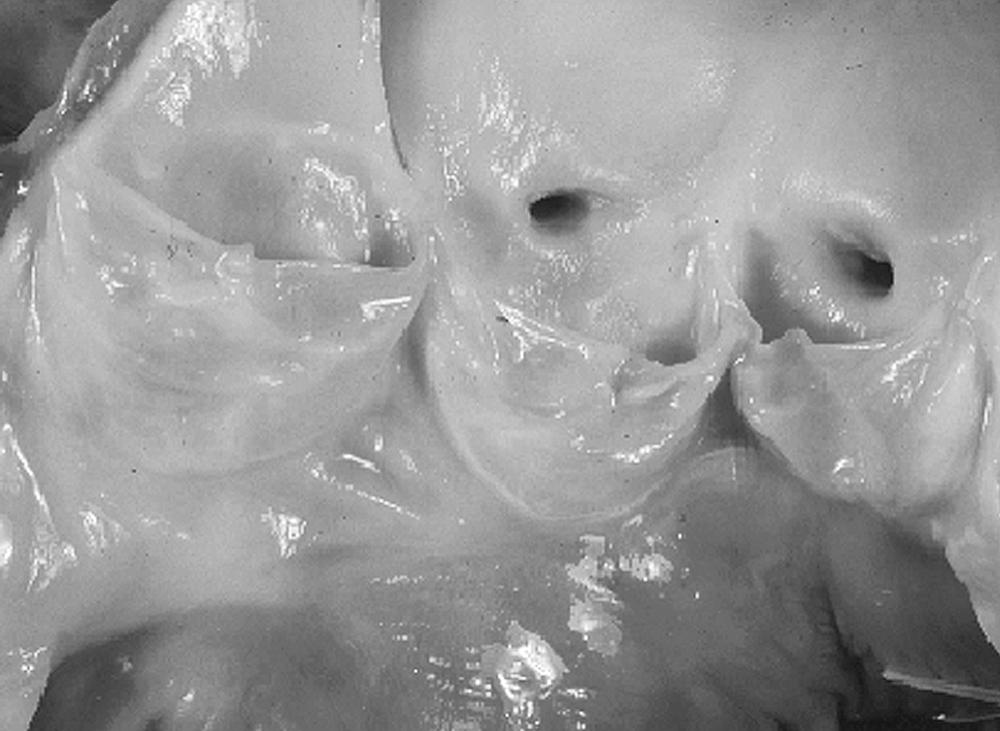
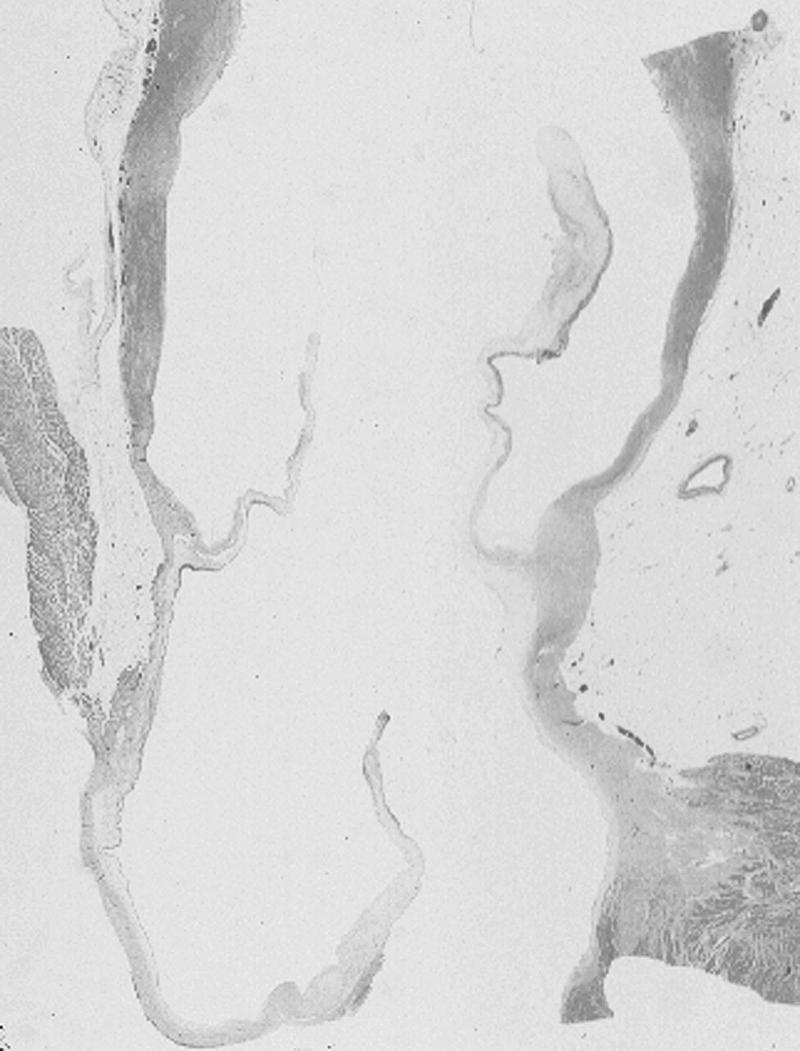
The normal aortic valve has three cusps. Each cusp has a semilunar shape and has a base and a free margin. The base is attached to the aortic annulus in a crescent fashion. The point at which the free margin of a cusp joins its base is the commissure, and the ridge in the aortic wall that lies immediately above the commissures is the sinotubular junction. The spaces contained between the aortic annulus and the sinotubular junction are the aortic sinuses, or sinuses of Valsalva. There are three cusps and three sinuses: left cusp and sinus, right cusp and sinus, and noncoronary cusp and sinus. The left main coronary artery arises from the left aortic sinus, and the right coronary artery arises from the right aortic sinus.
The normal aortic root has a fairly consistent shape, and the sizes of the cusps, the aortic annulus, the aortic sinuses, and the sinotubular junction are somewhat interdependent. Thus, large cusps have a proportionally large annulus, sinus, and sinotubular junction. The three aortic cusps often have different sizes in a person, and the right and noncoronary cusps are usually larger than the left cusp. The same cusp may have different sizes in individuals with the same body surface area. There are, however, certain geometric parameters that are fairly constant among the various components of the aortic root, and this knowledge is indispensable to understanding the principles of aortic valve repair or replacement with stentless biological valves.
The free margin of an aortic cusp extends from one of its commissures to the other. The length of the free margin of an aortic cusp is approximately 1.5 times the length of its base ( Fig. 67-3 ). During diastole, the free margins and part of the body of the three cusps touch each other approximately in the center of the aortic root to seal the aortic orifice. Thus, the average length of the free margins of three aortic cusps must exceed the diameter of the sinotubular junction to allow the cusps to coapt centrally and render the aortic valve competent. If a pathologic process causes shortening of the length of the free margin of a cusp, or if the sinotubular junction dilates, the cusps cannot coapt centrally, resulting in aortic insufficiency ( Fig. 67-4 ). If the length of a free margin is elongated, the cusp prolapses, and depending on the degree of prolapse, aortic insufficiency ensues ( Fig. 67-5 ).
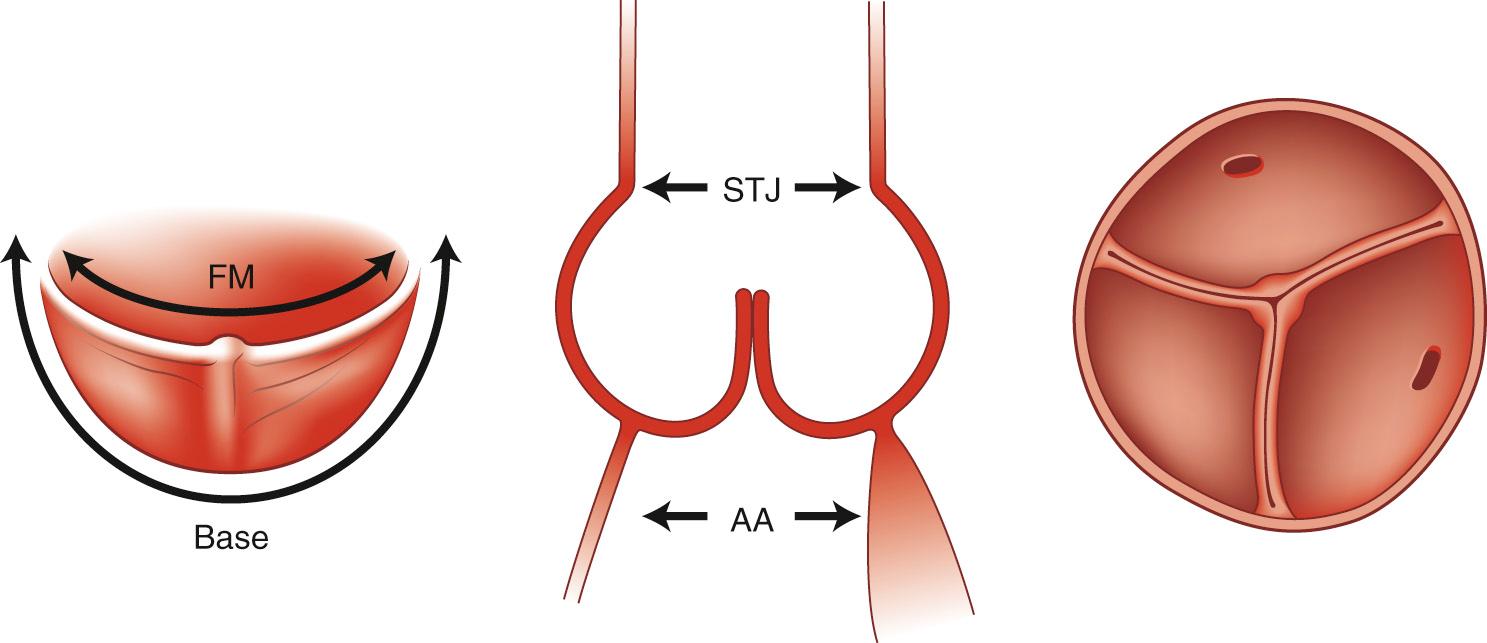
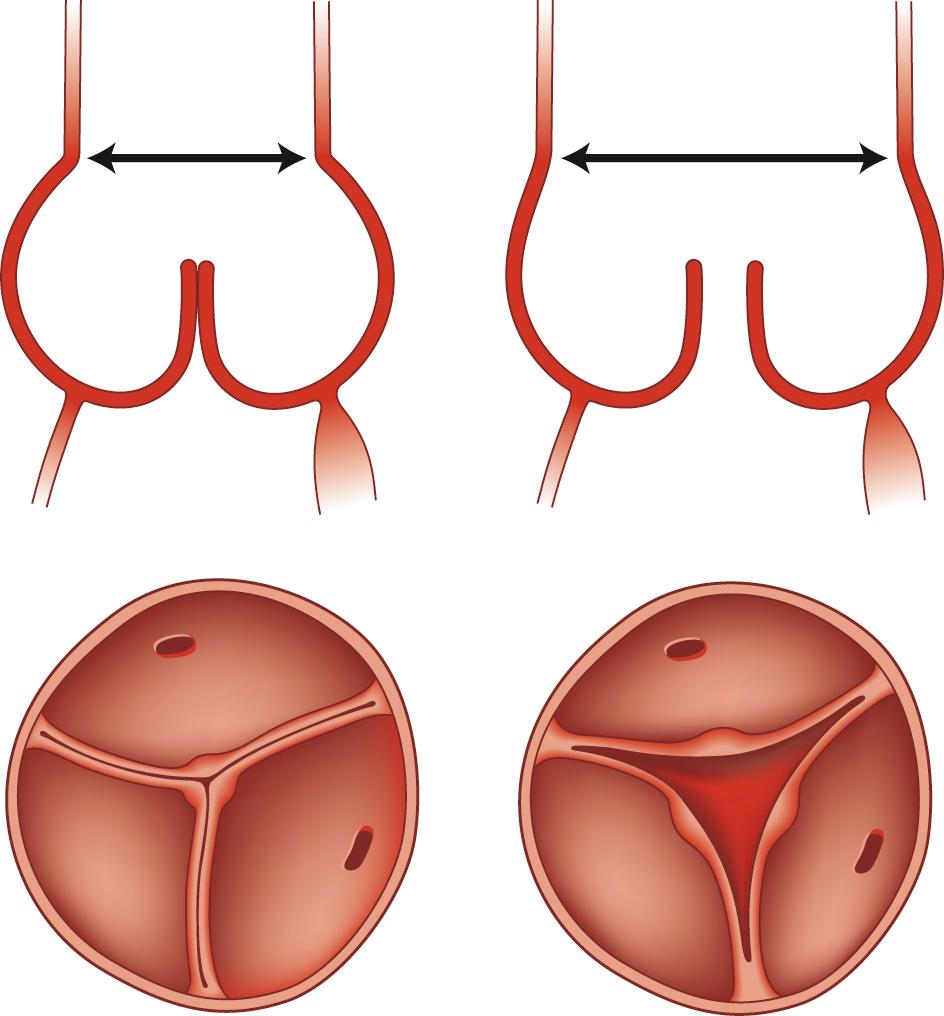
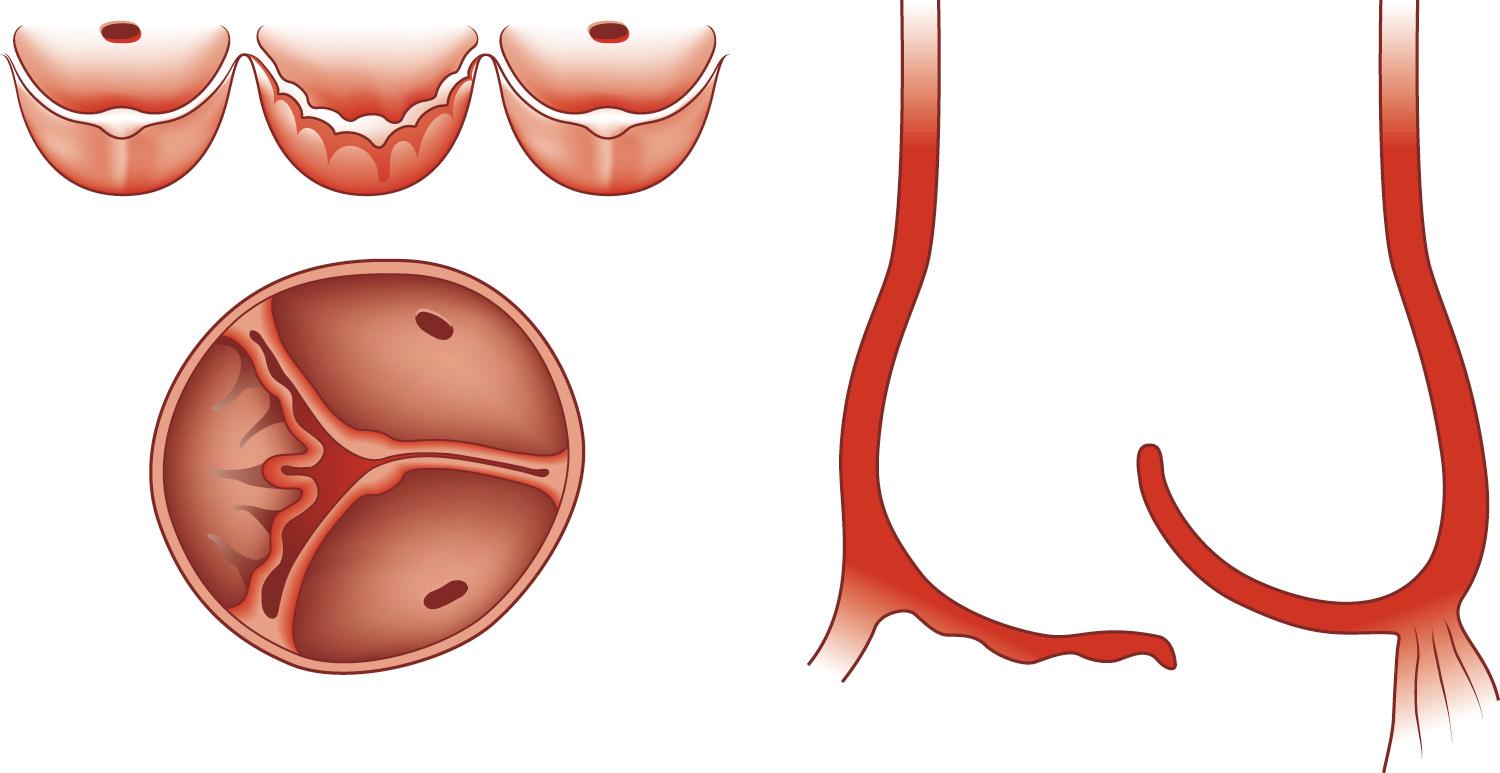
The diameter of the aortic annulus is 10% to 20% larger than the diameter of the sinotubular junction of the aortic root in young patients (see Fig. 67-3 ). As the number of elastic fibers in the arterial wall decreases with age, the sinotubular junction dilates, and its diameter tends to become equal to that of the aortic annulus in older patients.
Dilation of the aortic annulus pulls the belly of the aortic cusps apart, decreasing the coaptation area, and it eventually causes aortic insufficiency ( Fig. 67-6 ). With dilation of the aortic annulus, the subcommissural triangles of the noncoronary cusp tend to become more obtuse as the crescent shape of the aortic annulus along its fibrous insertion flattens (see Fig. 67-6 ). The subcommissural triangle beneath the right and left cusps does not change much in patients with annuloaortic ectasia, because it is part of the muscular interventricular septum and is not affected by the connective tissue disorder that causes dilation of the fibrous skeleton of the heart.
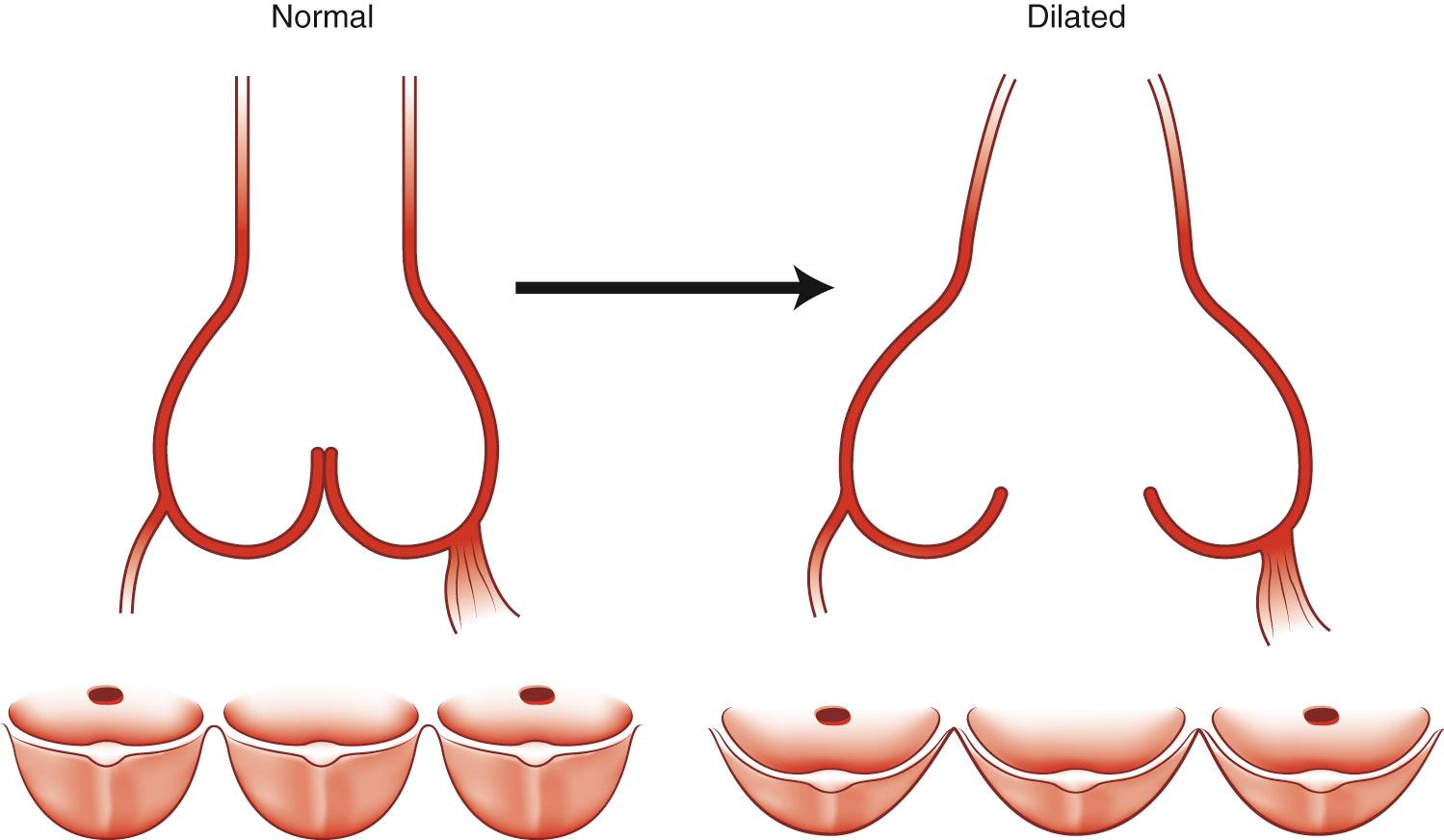
The aortic sinuses facilitate closure of the aortic valve by creating eddies and currents between the cusps and arterial wall ( Fig. 67-7 ). They also prevent the cusps from occluding the coronary artery orifices during systole, thus guaranteeing myocardial perfusion during the entire cardiac cycle. Isolated dilation of the aortic sinuses does not cause aortic insufficiency.
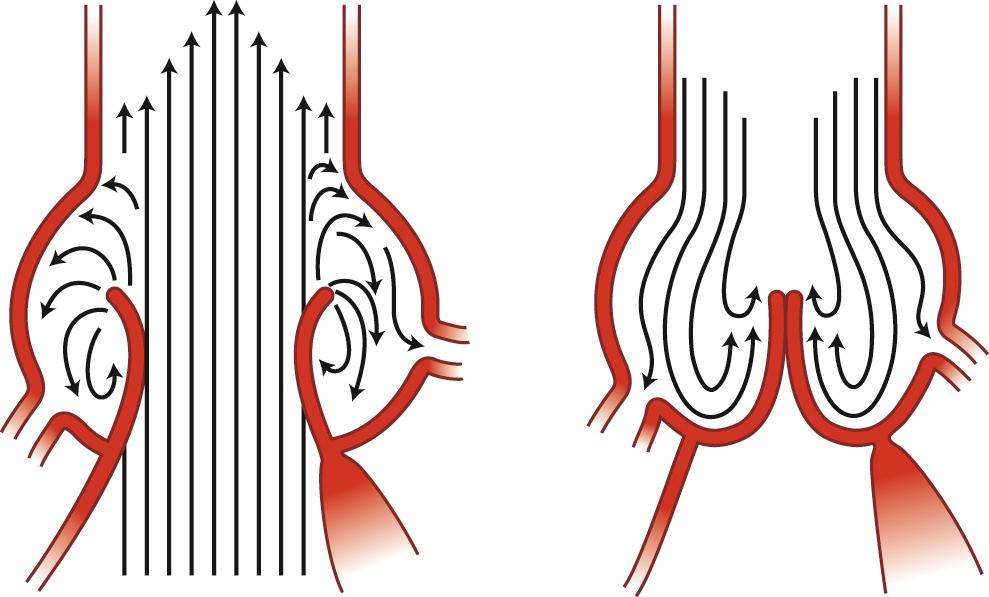
The aortic root of young individuals is elastic and very compliant. It expands and contracts during the cardiac cycle. Expansion and contraction of the aortic annulus are heterogeneous, probably because of its attachments to contractile myocardium and to fibrous structures such as the membranous septum and intervalvular fibrous body. On the other hand, the expansion and contraction of the sinotubular junction are more uniform. The aortic root also displays some degree of torsion during isovolumic contraction and ejection of the left ventricle. Compliance decreases with aging because of loss of elastic fibers, and the movements of the aortic annulus, cusps, sinuses, and sinotubular junction also change.
The wall of the aorta is composed of three layers: intima, media, and adventitia. The intima is a thin layer of ground substance lined by endothelium, and it is easily traumatized. The media is the thickest of the three layers, and it is made of elastic fibers arranged in spiral fashion to increase the tensile strength. The adventitia is a thin, fibrous layer and contains the vasa vasorum, which carries the nutrients to the media. The aorta is highly compliant, and it expands and contracts during the cardiac cycle because of the elastic fibers in the media. Compliance decreases with aging because of fragmentation of the elastic fibers and an increase in the amount of fibrous tissue in the media. Hypertension, hypercholesterolemia, and coronary artery disease cause premature aging of the aorta. Exercise seems to protect the elasticity of the aorta.
Degenerative diseases of the media with aneurysm formation are the most common disorders of the aortic root and ascending aorta. A broad spectrum of pathologic and clinical entities is grouped under degenerative disorders, ranging from severe degeneration of the media, which can become clinically important early in life in cases such as Marfan syndrome in children, to cases of the not so important mild dilation of the ascending aorta in older adults. Bicuspid and unicusp aortic valve diseases are often associated with dilation of the aorta. Atherosclerosis, infectious and noninfectious aortitis, and trauma are other pathologic entities with which the cardiac surgeon must be familiar. Primary tumors of the aortic root and ascending aorta are rare. False aneurysms and aortic root abscess are problems commonly encountered in clinical practice.
Degenerative aneurysms of the thoracic aorta in older patients are often related to risk factors such as smoking, hypertension, and hyperlipidemia. In young patients without risk factors, the explanation for aneurysm formation is on a genetic basis. Genetic aneurysms of the aorta can be classified into three main groups:
Inherited syndromes predisposing to early onset of aortic aneurysms, such as Marfan syndrome, Loeys-Dietz syndrome, and aneurysm-osteoarthritis syndrome
Familial aneurysms
Sporadic aneurysms including young patients without family history of aneurysm
Aneurysms of the proximal aorta are often caused by cystic medial degeneration (cystic medial necrosis). Histologically, necrosis and disappearance of muscle cells in the elastic lamina, and cystic spaces filled with mucoid material are often observed. Although these changes occur more often in the proximal aorta, they can affect any portion or the entire aorta. These changes weaken the arterial wall, which dilates and forms a fusiform aneurysm. The aortic root may be involved in this pathologic process, and in patients with Marfan syndrome, the aneurysm usually begins in the aortic sinuses. Patients with aortic root aneurysms are usually in their second or third decade of life when the diagnosis is made. Other patients have relatively normal aortic roots but develop ascending aortic aneurysms. These patients are usually in their fifth or sixth decade of life. Finally, certain patients have extensive degenerative disease of the entire aorta and develop the so-called mega-aorta syndrome with dilation of the thoracic and abdominal aorta.
Ascending aortic aneurysms tend to increase in size and eventually rupture or cause aortic dissection. The transverse diameter of the aneurysm is the most important predictor of rupture or dissection. In a study by Coady and associates of 370 patients with thoracic aneurysms (201 ascending aortic aneurysms), during a mean follow-up of 29.4 months, the incidence of acute dissection or rupture was 8.8% for aneurysms smaller than 4 cm, 9.5% for aneurysms of 4 to 4.9 cm, 17.8% for 5 to 5.9 cm, and 27.9% for those larger than 6 cm. The median size of the ascending aortic aneurysm at the time of rupture or dissection was 5.9 cm.
The growth rates of thoracic aneurysms are exponential. In the study by Coady and associates, the growth rate ranged from 0.08 cm/yr for small (<4 cm) aneurysms to 0.16 cm/yr for large (8 cm) aneurysms. The growth rates for chronic dissecting aneurysms were much higher than for chronic nondissecting aneurysms. Other studies found greater annual growth rates than did the Coady group. In addition, the growth rates for aortic root aneurysms may be different from those of ascending aortic aneurysms.
Most patients with aortic root or ascending aortic aneurysms are asymptomatic, and the aneurysm is usually found during routine chest radiographs, which show a widened mediastinum. Tracheal and esophageal displacement may be observed in the posterolateral view of the chest radiographs. Approximately one third of the patients complain of vague chest pain. In patients with a massive ascending aortic aneurysm, signs of superior vena cava obstruction may be present. If aortic insufficiency is present, there may be cardiac enlargement and the physical findings associated with it. The diagnoses of aortic root and ascending aortic aneurysm can be confirmed with echocardiography.
Transesophageal echocardiography is the best diagnostic tool to study aortic root aneurysm and the mechanism of aortic insufficiency. The echocardiographer should obtain information on each component of the aortic root, and particularly the aortic cusps. The number of cusps, their thickness, the appearance of free margins, and the excursion of each cusp during the cardiac cycle must be observed carefully. The coaptation areas of the cusps should also be investigated in multiple views, and Doppler imaging should be recorded. Information regarding the morphologic features of the aortic sinuses, sinotubular junction, and ascending aorta is also important. The diameters of the aortic annulus, aortic sinuses, sinotubular junction, and ascending aorta should be obtained in multiple views. The lengths of the free margins of the cusps should be estimated if possible. The mechanism of aortic insufficiency can often be determined with transesophageal echocardiography. Dilation of the sinotubular junction is a common cause of aortic insufficiency in patients with ascending aortic aneurysm and normal aortic cusps. Dilation of the aortic annulus and of the sinotubular junction is usually the cause of aortic insufficiency in patients with aortic root aneurysm. Although fenestrations in the cusps are not easily seen with echocardiography, a regurgitant jet in a commissural area is suggestive of fenestration.
Computed tomography (CT) with intravenous contrast enhancement permits accurate evaluation of the extent and size of the aneurysm. Three-dimensional imaging techniques can provide additional information on the extensiveness and type of aneurysm (e.g., fusiform or saccular).
Magnetic resonance imaging (MRI) provides even more information than CT scanning because it visualizes the arterial wall and surrounding structures with greater contrast. In addition, it has been increasingly used in the diagnosis and management of patients with heart diseases. Magnetic resonance angiography is replacing contrast angiography.
Marfan syndrome is an autosomal dominant, variably penetrant, inherited disorder of the connective tissue in which cardiovascular, skeletal, ocular, and other abnormalities may be present to variable degrees. The prevalence is estimated to be approximately 1 in 5000 individuals. It is caused by mutations in the gene that encodes fibrillin-1 (FBN1) on chromosome 15. This is a large gene (approximately 10,000 nucleotides in the messenger RNA), and identification of the mutation is a complex task. More than 1000 mutations in FBN1 have been identified. The phenotype is highly variable because of varying genotype expression.
The clinical features of Marfan syndrome were thought to be caused by weaker connective tissues resulting from defects in FBN1, a glycoprotein and principal component of the extracellular matrix microfibril. This concept was inadequate to explain the overgrowth of long bones, osteopenia, reduced muscular mass and adiposity, and craniofacial abnormalities often seen in Marfan syndrome. Dietz and colleagues showed in experimental mice with Marfan syndrome that many findings are the result of abnormal levels of activation of transforming growth factor β (TGF-β), a potent stimulator of inflammation, fibrosis, and activation of certain matrix metalloproteinases, especially matrix metalloproteinases 2 and 9. Excess TGF-β activation in tissues correlates with failure of lung septation, development of a myxomatous mitral valve, and aortic root dilation in mice. This combination of structural microfibril matrix abnormality, dysregulation of matrix homeostasis mediated by excess TGF-β, and abnormal cell–matrix interactions is responsible for the phenotypic features of Marfan syndrome. Ongoing destruction of the elastic and collagen lamellae and medial degeneration result in progressive dilation of the aortic root, as well as in a predisposition to aortic dissection from the loss of appropriate medial layer support. Loss of elasticity in the media causes increased aortic stiffness and decreased distensibility.
The main features of Marfan syndrome include disproportionate long bone overgrowth, ectopia lentis and aortic root aneurysm. Diagnosis is not always simple, and a multidisciplinary approach is needed to diagnose and manage patients with this autosomal dominant disorder. In 1996, a panel of experts developed the “Ghent criteria” for the diagnosis of Marfan syndrome. Table 67-1 shows the original Ghent criteria, which contain a set of “major” and “minor” manifestations in various organs including cardiovascular, ocular, skeletal, pulmonary, dura mater, and skin. The presence of major criteria in two separate systems and involvement of a third (minor or major) was needed to establish the diagnosis of Marfan syndrome. Using these criteria, a high proportion of patients diagnosed as Marfan are found to have FBN1 mutations. However, some manifestations contained in the Ghent criteria are age dependent, and there are patients with skeletal abnormalities and ectopia lentis without aortic root aneurysm, even in the presence of FBN1 mutations. Experts in this area got together again and developed a “Revised Ghent Nosology for the Marfan Syndrome” ( Box 67-1 ) which emphasizes aortic root aneurysm, ascending aortic dissection and ectopia lentis.
| System | Major Criteria | Minor Criteria |
|---|---|---|
| Family history | Independent diagnosis in parent, child, sibling | None |
| Genetics | Mutation in FBN1 | None |
| Cardiovascular | Aortic root dilation Dissection of ascending aorta |
Mitral valve prolapse Calcification of the mitral valve (age < 40 yr) Dilation of the pulmonary artery Dilation or dissection of the descending aorta |
| Ocular | Ectopia lentis | Two needed: Flat cornea Myopia Elongated globe |
| Skeletal | Pectus excavatum needing surgery Pectus carinatum Pes planus Wrist and thumb sign Scoliosis > 20 degrees or spondylolisthesis Arm span–height ratio > 1.05 Protrusio acetabula (radiograph, MRI) Diminished extension elbows (<170 degrees) |
Two major or one major and two minor signs: Moderate pectus excavatum High, narrowly arched palate Typical facies Joint hypermobility |
| Pulmonary | — | Spontaneous pneumothorax Apical bullae |
| Skin | — | Unexplained stretch marks (striae) Recurrent or incisional hernia |
| Central nervous | Lumbosacral dural ectasia (CT or MRI) | — |
* The presence of major criteria in two separate systems and involvement of a third (minor or major) are needed to establish the diagnosis of Marfan syndrome.
Aortic root dilation (Z > 2) or dissection and ectopia lentis = Marfan
Aortic root dilation (Z > 2) or dissection and FBN1 mutation = Marfan
Aortic root dilation (Z > 2) or dissection and systemic score ≥7 points = Marfan
Ectopia lentis and FBN1 known to associated aortic root dilation/dissection
Ectopia lentis and family history of Marfan
Systemic score (≥7 points) and family history of Marfan
Aortic root dilation (Z ≥ 2 in >20 years of age; Z ≥ 3 in <20 years of age) and family history of Marfan
The most common cardiovascular features of Marfan syndrome are aortic root aneurysm and mitral valve prolapse. These anatomic abnormalities may cause aortic rupture, aortic dissection, aortic insufficiency, and mitral insufficiency.
Mitral valve prolapse is age dependent and is more common in women. It is caused by myxomatous degeneration of the mitral valve apparatus, which is present in up to 80% of patients with Marfan syndrome, but only 25% of them develop mitral insufficiency. The posterior mitral annulus is grossly dilated in patients with mitral insufficiency, and it is often displaced posteriorly. The mitral annulus can also become heavily calcified and display a horseshoe appearance on radiographs.
The dilation of the aortic root is often progressive, and the rate of expansion, which varies somewhat, is usually less than 1 or 2 mm/yr. Shores and colleagues randomized 70 patients with Marfan syndrome into propranolol-treated and placebo groups. The growth rates of the aortic root aneurysms in untreated patients were slightly more than three times those of patients who received β-adrenergic blockage. This study has been the scientific basis to treat these patients with a β-blocker agent. Calcium antagonists and angiotension-converting enzymes have also been reported as effective in delaying aortic dilation, but at present, β-blocker remains the drug of choice. A prospective randomized clinical trial showed that losartan is effective in reducing the rate of aortic root dilation in patients with Marfan syndrome, and it reduces the rate of dilation of the arch after aortic root replacement. The combination of losartan with a β-blocker was more effective in preventing dilation of the aortic root than β-blocker alone in a small, randomized trial in children.
Aortic dissection is rare in patients with aortic root aneurysm of less than 50 mm, unless they have a family history of aortic dissection. The dissection in most patients starts at the level of the sinotubular junction (Stanford type A aortic dissection). Surgery of the aortic root is recommended when the transverse diameter of the aortic sinuses reaches 50 mm. In patients with family history of dissection, surgery should be considered when the diameter reaches 45 mm. Without surgery, most patients with Marfan syndrome die in their third decade, from complications of aortic root aneurysm such as rupture, aortic dissection, or aortic insufficiency. In approximately 10% of patients, the dissection starts just beyond the left subclavian artery (Stanford type B aortic dissection).
Patients with Marfan syndrome should be followed at regular time intervals. Doppler echocardiography is the best diagnostic tool for monitoring changes in the mitral valve and aortic root. Patients with an aortic root greater than 40 mm should be followed with echocardiographic measurements twice yearly. MRI of the remaining thoracic and abdominal aorta should also be used when indicated.
Pregnancy in women with Marfan syndrome has two potential problems: the risk of having a child who will inherit the disorder and the risk of acute aortic dissection during the third trimester, parturition, or the first postpartum month. Offspring have a 50% risk of inheriting the syndrome. The risk of aortic dissection is less known, but it appears to be low in patients with normal aortic root and cardiac function.
Mutations in the genes encoding TGF-β receptors 1 and 2 have been found in association with a continuum of clinical features. On the mild end is a presentation similar to that of the Marfan syndrome, or familial thoracic aneurysm and dissection, and on the severe end, there is a complex phenotype in which aortic dissection or rupture commonly occurs in childhood. This complex phenotype is characterized by the triad of hypertelorism, bifid uvula (or cleft palate), and generalized arterial tortuosity with widespread vascular aneurysm and dissection. This phenotype has been classified as Loeys-Dietz syndrome. Affected patients have a high risk of aortic dissection or rupture at an early age and at relatively small aortic diameters. CT angiograms should be obtained from the head to the pelvis. Surgery is recommended for adults when the aortic root exceeds 4 cm or the descending thoracic aorta exceeds 5 cm. If the craniofacial features are severe in children, surgery is recommended when the aortic root z-score is greater than 3, or when the expansion is greater than 0.5 cm in 1 year.
The Ehlers-Danlos syndrome encompasses a group of heterogeneous connective tissue disorders that involve the skin and joints and cause hyperelasticity and fragility of the former and hypermobility of the latter. It can also involve the cardiovascular system. Vascular Ehlers-Danlos syndrome is a rare autosomal dominant inherited disorder of the connective tissue resulting from mutation of the COL3A1 gene encoding type III collagen. Afflicted individuals are prone to serious vascular, intestinal, and obstetric complications. These problems are rare during infancy but occur in up to 25% of affected persons before the age of 20 years and in 80% before the age of 40. Median survival is 48 years. Spontaneous rupture without dissection of large- and medium-caliber arteries, such as the abdominal aorta and its branches, the branches of the aortic arch, and the large arteries of the limbs accounts for most deaths. Intestinal perforation, usually involving the colon, is less often fatal. Pregnancy is a high risk for women with this syndrome. Aortic root dilation was present in 28% in a series of 71 patients with Ehlers-Danlos syndrome. Aortic dissection is uncommon.
As with many rare diseases, delayed or incorrect diagnosis can lead to inadequate or inappropriate management. Diagnosis is based on clinical findings, including specific facial features, thin translucent skin, propensity to bleeding, and rupture of vessels or viscera. Diagnosis can be confirmed by biochemical assays showing qualitative or quantitative abnormalities in type III collagen secretion, or by molecular biology studies demonstrating mutation of the COL3A1 gene. Varied molecular mechanisms have been observed with different mutations in each family. No correlation has been established between genotype and phenotype. Diagnosis should be suggested in any young person with arterial or visceral rupture or colonic perforation. There is currently no specific treatment for this syndrome.
Congenital aortic valve malformations include a phenotypic continuum of unicuspid valves (severe form), the various types of bicuspid aortic valves (moderate form), tricuspid valves (normal), and the rare quadricuspid valves.
Bicuspid aortic valve, the most common of these malformations, occurs in 1% to 2% of the population. Movahed and colleagues recently reviewed 24,265 patients who had echocardiograms performed for various clinical reasons, and 1742 echocardiograms obtained by screening teenage athletes in Southern California, and found a prevalence of bicuspid aortic valves of 0.6% in the large cohort and 0.5% in the smaller one. Males are affected more than females at a ratio of 4 : 1. There is a relatively high incidence of familial clustering, which suggests an autosomal dominant inheritance with reduced penetrance ; however, it remains unproved that bicuspid aortic valve is an inherited disorder. Patients with bicuspid aortic valve usually have three aortic sinuses and two cusps of different sizes. The larger cusp, usually the one attached to the interventricular septum, contains a raphe, which probably represents an incomplete commissure. The raphe extends from the mid portion of the cusp to the aortic annulus, and its insertion in the aortic root is at a lower level than the other two commissures. Bicuspid aortic valves with two cusps and two sinuses are uncommon and called “type 0”; the most common type is with one raphe and is called “type 1,” and finally with two raphes is “type 2.” Types 1 and 2 can be subclassified according to the fused cusps: left-right is the most common form (a raphe in between the left and right cusps). Abnormal origin of the coronary arteries and circumflex artery dominance are common in patients with bicuspid aortic valve.
Normally functioning bicuspid aortic valves may last the patient's lifetime. Others become stenotic by the fourth or fifth decade of life. Aortic insufficiency can also occur, and it is often associated with dilated aortic annulus. It is more common in younger patients, and it results from the prolapse of one cusp, usually the one that contains the raphe.
Both bicuspid and unicuspid aortic valves are often associated with premature degenerative changes in the media of the wall of the aortic root and ascending aorta. These patients are at risk of developing chronic degenerative aneurysms of the ascending aorta and type A aortic dissection.
Become a Clinical Tree membership for Full access and enjoy Unlimited articles
If you are a member. Log in here